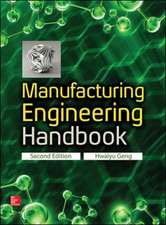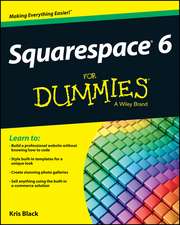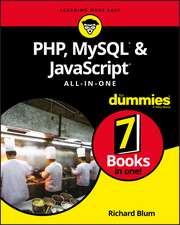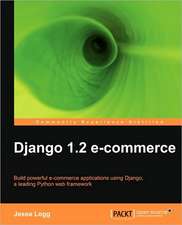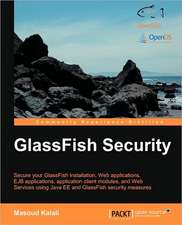Internet of Things and Data Analytics Handbook: Cărți IoT - Internet of Things
Autor H Gengen Limba Engleză Hardback – 23 mar 2017
Internet of Things and Data Analytics Handbookdescribes essential technical knowledge, building blocks, processes, design principles, implementation, and marketing for IoT projects. It provides readers with knowledge in planning, designing, and implementing IoT projects. The book is written by experts on the subject matter, including international experts from nine countries in the consumer and enterprise fields of IoT. The text starts with an overview and anatomy of IoT, ecosystem of IoT, communication protocols, networking, and available hardware, both present and future applications and transformations, and business models. The text also addresses big data analytics, machine learning, cloud computing, and consideration of sustainability that are essential to be both socially responsible and successful. Design and implementation processes are illustrated with best practices and case studies in action. In addition, the book:
- Examines cloud computing, data analytics, and sustainability and how they relate to IoT
- overs the scope of consumer, government, and enterprise applications
- Includes best practices, business model, and real–world case studies
Preț: 900.18 lei
Preț vechi: 1125.22 lei
-20% Nou
172.27€ • 177.97$ • 143.37£
Carte tipărită la comandă
Livrare economică 26 martie-09 aprilie
Specificații
ISBN-10: 1119173647
Pagini: 816
Dimensiuni: 156 x 234 x 44 mm
Greutate: 1.27 kg
Editura: Wiley
Seria Cărți IoT - Internet of Things
Locul publicării:Hoboken, United States
Public țintă
Senior engineers, project managers, and executives working on IoT/CPS projects.Descriere
This book examines the Internet of Things (IoT) and Data Analytics from a technical, application, and business point of view.
Internet of Things and Data Analytics Handbook describes essential technical knowledge, building blocks, processes, design principles, implementation, and marketing for IoT projects. It provides readers with knowledge in planning, designing, and implementing IoT projects. The book is written by experts on the subject matter, including international experts from nine countries in the consumer and enterprise fields of IoT. The text starts with an overview and anatomy of IoT, ecosystem of IoT, communication protocols, networking, and available hardware, both present and future applications and transformations, and business models. The text also addresses big data analytics, machine learning, cloud computing, and consideration of sustainability that are essential to be both socially responsible and successful. Design and implementation processes are illustrated with best practices and case studies in action. In addition, the book:
- Examines cloud computing, data analytics, and sustainability and how they relate to IoT
- overs the scope of consumer, government, and enterprise applications
- Includes best practices, business model, and real–world case studies
Hwaiyu Geng, P.E., is a consultant with Amica Research (www.AmicaResearch.org, Palo Alto, California), promoting green planning, design, and construction projects. He has had over 40 years of manufacturing and management experience, working with Westinghouse, Applied Materials, Hewlett Packard, and Intel on multi–million high–tech projects. He has written and presented numerous technical papers at international conferences. Mr. Geng, a patent holder, is also the editor/author of Data Center Handbook (Wiley, 2015).
Textul de pe ultima copertă
This book examines the Internet of Things (IoT) and Data Analytics from a technical, application, and business point of view.
Internet of Things and Data Analytics Handbook describes essential technical knowledge, building blocks, processes, design principles, implementation, and marketing for IoT projects. It provides readers with knowledge in planning, designing, and implementing IoT projects. The book is written by experts on the subject matter, including international experts from nine countries in the consumer and enterprise fields of IoT. The text starts with an overview and anatomy of IoT, ecosystem of IoT, communication protocols, networking, and available hardware, both present and future applications and transformations, and business models. The text also addresses big data analytics, machine learning, cloud computing, and consideration of sustainability that are essential to be both socially responsible and successful. Design and implementation processes are illustrated with best practices and case studies in action. In addition, the book:
- Examines cloud computing, data analytics, and sustainability and how they relate to IoT
- Covers the scope of consumer, government, and enterprise applications
- Includes best practices, business model, and real–world case studies
Cuprins
List of Contributors xix
Foreword xxiii
Preface xxvii
Acknowledgments xxix
Part I INTERNET OF THINGS 1
1 Internet of Things and Data Analytics in the Cloud with Innovation and Sustainability 3
Hwaiyu Geng
1.1 Introduction 3
1.2 The IoT and the Fourth Industrial Revolution 4
1.3 Internet of Things Technology 6
1.4 Standards and Protocols 11
1.5 IoT Ecosystem 11
1.6 Definition of Big Data 13
1.7 IoT, Data Analytics, and Cloud Computing 18
1.8 Creativity, Invention, Innovation, and Disruptive Innovation 18
1.9 Polya s How to Solve it 20
1.10 Business Plan and Business Model 20
1.11 Conclusion and Future Perspectives 23
2 Digital Services and Sustainable Solutions 29
Rikke Gram–Hansen
2.1 Introduction 29
2.2 Why IoT is not Just Nice to Have 30
2.3 Services in a Digital Revolution 32
2.4 Mobile Digital Services and the Human Sensor 32
2.5 Not Just Another App 33
2.6 The Hidden Life of Things 34
2.7 The Umbrellas are not what they Seem 35
2.8 Interacting with the Invisible 36
2.9 Society as Open Source 36
2.10 Learn from your Hackers 37
2.11 Ensuring High–Quality Services to Citizens 37
2.12 Government as a Platform 38
2.13 Conclusion 38
3 The Industrial Internet of Things (Iiot): Applications and Taxonomy 41
Stan Schneider
3.1 Introduction to the IioT 41
3.2 Some Examples of Iiot Applications 43
3.3 Toward a Taxonomy of the Iiot 52
3.4 Standards and Protocols for Connectivity 66
3.5 Connectivity Architecture for the Iiot 73
3.6 Data–Centricity Makes Dds Different 79
3.7 The Future of the Iiot 80
4 Strategic Planning for Smarter Cities 83
Jonathan Reichental
4.1 Introduction 83
4.2 What is a Smart City? 84
4.3 Smart Cities and the Internet of Things 85
4.4 Why Strategic Planning Matters 86
4.5 Beginning the Journey: First Things First 87
4.6 From Vision to Objectives to Execution 89
4.7 Pulling it all Together 91
5 Next–Generation Learning: Smart Medical Team Training 95
Brenda Bannan, Shane Gallagher and Bridget Lewis
5.1 Introduction 95
5.2 Learning, Analytics, and Internet of Things 96
5.3 IoT Learning Design Process 98
5.4 Conclusion 103
6 The Brain Computer Interface in the Internet of Things 107
Jim McKeeth
6.1 Introduction 107
6.2 The Science Behind Reading the Brain 109
6.3 The Science of Writing to the Brain 112
6.4 The Human Connectome Project 113
6.5 Consumer Electroencephalography Devices 113
6.6 Summary 115
7 Iot Innovation Pulse 119
John Mattison
7.1 The Convergence of Exponential Technologies as a Driver of Innovation 119
7.2 Six Dimensions of the Plecosystem 119
7.3 Five Principles of the Plecosystem 120
7.4 The Biologic Organism Analogy for the IoT 121
7.5 Components for Innovation with the Organismal Analog 122
7.6 Spinozan Value Trade–Offs 123
7.7 Human IoT Sensor Networks 123
7.8 Role of the IoT in Social Networks 124
7.9 Security and Cyberthreat Resilience 124
7.10 IoT Optimization for Sustainability of our Planet 124
7.11 Maintenance of Complex IoT Networks 125
7.12 The Accordion Model of Learning as a Source of Innovation 126
7.13 Summary 126
Part II INTERNET OF THINGS TECHNOLOGIES 129
8 Internet of Things Open–Source Systems 131
Scott Amyx
8.1 Introduction 131
8.2 Background of Open Source 131
8.3 Drivers for Open Source 132
8.4 Benefits of Using Open Source 132
8.5 IoT Open–Source Consortiums and Projects 134
8.6 Finding the Right Open–Source Project for the Job 137
8.7 Conclusion 143
9 MEMS: An Enabling Technology for the Internet of Things (IoT) 147
Michael A. Huff
9.1 The Ability to Sense, Actuate, and Control 148
9.2 What are MEMS? 150
9.3 MEMS as an Enabling Technology for the IoT 153
9.4 MEMS Manufacturing Techniques 155
9.5 Examples of MEMS Sensors 158
9.6 Example of MEMS Actuator 163
9.7 The Future of MEMS for the IoT 163
9.8 Conclusion 165
10 Electro–Optical Infrared Sensor Technologies for the Internet of Things 167
Venkataraman Sundareswaran, Henry Yuan, Kai Song, Joseph Kimchi and Jih–Fen Lei
10.1 Introduction 167
10.2 Sensor Anatomy and Technologies 169
10.3 Design Considerations 176
10.4 Applications 179
10.5 Conclusion 184
11 Ipv6 for IoT and Gateway 187
Geoff Mulligan
11.1 Introduction 187
11.2 Ip: The Internet Protocol 187
11.3 IPv6: The Next Internet Protocol 189
11.4 6LoWPAN: Ip for IoT 191
11.5 Gateways: A Bad Choice 191
11.6 Example IoT Systems 192
11.7 An IoT Data Model 194
11.8 The Problem of Data Ownership 194
11.9 Managing the Life of an IoT Device 195
11.10 Conclusion: Looking forward 195
12 Wireless Sensor Networks 197
David Y. Fong
12.1 Introduction 197
12.2 Characteristics of Wireless Sensor Networks 198
12.3 Distributed Computing 201
12.4 Parallel Computing 202
12.5 Self–Organizing Networks 205
12.6 Operating Systems for Sensor Networks 206
12.7 Web of Things (WoT) 207
12.8 Wireless Sensor Network Architecture 208
12.9 Modularizing the Wireless Sensor Nodes 209
12.10 Conclusion 210
13 Networking Protocols and Standards for Internet of Things 215
Tara Salman and Raj Jain
13.1 Introduction 215
13.2 IoT Data Link Protocols 218
13.3 Network Layer Routing Protocols 224
13.4 Network Layer Encapsulation Protocols 225
13.5 Session Layer Protocols 227
13.6 IoT Management Protocols 232
13.7 Security in IoT Protocols 233
13.8 IoT Challenges 234
13.9 Summary 235
14 IoT Architecture 239
Shyam Varan Nath
14.1 Introduction 239
14.2 Architectural Approaches 239
14.3 Business Markitecture 242
14.4 Functional Architecture 243
14.5 Application Architecture 243
14.6 Data and Analytics Architecture 246
14.7 Technology Architecture 246
14.8 Security and Governance 248
15 A Designer s Guide to the Internet of Wearable Things 251
David Hindman and Peter Burnham
15.1 Introduction 251
15.2 Interface Glanceability 252
15.3 The Right Data at the Right Time 254
15.4 Consistency Across Channels 255
15.5 From Public to Personal 260
15.6 Nonvisual Ui 262
15.7 Emerging Patterns 264
15.8 Conclusion 265
16 Beacon Technology with IoT and Big Data 267
Nick Stein and Stephanie Urbanski
16.1 Introduction to Beacons 267
16.2 What is Beacon Technology 269
16.3 Beacon and BLE Interaction 270
16.4 Where Beacon Technology can be Applied/Used 271
16.5 Big Data and Beacons 273
16.6 San Francisco International Airport (Sfo) 274
16.7 Future Trends and Conclusion 280
17 SCADA Fundamentals and Applications in the IoT 283
Rich Hunzinger
17.1 Introduction 283
17.2 What Exactly is SCADA? 285
17.3 Why is SCADA the Right Foundation for an IoT Platform? 287
17.4 Case Study: Algae Lab Systems 290
17.5 The Future of SCADA and the Potential of the IoT 290
Part III DATA ANALYTICS TECHNOLOGIES 295
18 Data Analysis and Machine Learning Effort in Healthcare: Organization, Limitations, and Development of an Approach 297
Oleg Roderick, Nicholas Marko, David Sanchez and Arun Aryasomajula
18.1 Introduction 297
18.2 Data Science Problems in Healthcare 298
18.3 Qualifications and Personnel in Data Science 306
18.4 Data Acquisition and Transformation 310
18.5 Basic Principles of Machine Learning 316
18.6 Case Study: Prediction of Rare Events on Nonspecific Data 321
18.7 Final Remarks 324
19 Data Analytics and Predictive Analytics in the Era of Big Data 329
Amy Shi–Nash and David R. Hardoon
19.1 Data Analytics and Predictive Analytics 329
19.2 Big Data and Impact to Analytics 334
19.3 Conclusion 343
20 Strategy Development and Big Data Analytics 347
Neil Fraser
20.1 Introduction 347
20.2 Maximizing the Influence of Internal Inputs for Strategy Development 348
20.3 A Higher Education Case Study 352
20.4 Maximizing the Influence of External Inputs for Strategy Development 356
20.5 Conclusion 363
21 Risk Modeling and Data Science 365
Joshua Frank
21.1 Introduction 365
21.2 What is Risk Modeling 365
21.3 The Role of Data Science in Risk Management 366
21.4 How to Prepare and Validate Risk Model 367
21.5 Tips and Lessons Learned 374
21.6 Future Trends and Conclusion 380
22 Hadoop Technology 383
Scott Shaw
22.1 Introduction 383
22.2 What is Hadoop Technology and Application? 384
22.3 Why Hadoop? 386
22.4 Hadoop Architecture 388
22.5 HDFS: What and how to use it 391
22.6 YARN: What and how to use it 392
22.7 Mapreduce: What and how to use it 394
22.8 Apache: what and how to use it 395
22.9 Future Trend and Conclusion 396
23 Security of IoT Data: Context, Depth, and Breadth Across Hadoop 399
Pratik Verma
23.1 Introduction 399
23.2 IoT Data in Hadoop 402
23.3 Security in IoT Platforms Built on Hadoop 402
23.4 Architectural Considerations for Implementing Security in Hadoop 403
23.5 Breadth of Control 403
23.6 Context for Security 404
23.7 Security Policies and Rules Based on Pxp Architecture 404
23.8 Conclusion 405
Part Iv SMART EVERYTHING 407
24 Connected Vehicle 409
Adrian Pearmine
24.1 Introduction 409
24.2 Connected, Automated, and Autonomous Vehicle Technologies 410
24.3 Connected Vehicles from the Department of Transportation Perspective 413
24.4 Policy Issues Around DSRC 414
24.5 Alternative forms of V2X Communications 414
24.6 DOT Connected Vehicle Applications 415
24.7 Other Connected Vehicle Applications 418
24.8 Migration Path from Connected and Automated to Fully Autonomous Vehicles 419
24.9 Autonomous Vehicle Adoption Predictions 419
24.10 Market Growth for Connected and Autonomous Vehicle Technology 422
24.11 Connected Vehicles in the Smart City 423
24.12 Issues not Discussed in this Chapter 423
24.13 Conclusion 425
25 In–Vehicle Health and Wellness: An Insider Story 427
Pramita Mitra, Craig Simonds, Yifan Chen and Gary Strumolo
25.1 Introduction 427
25.2 Health and Wellness Enabler Technologies inside the Car 429
25.3 Health and Wellness as Automotive Features 435
25.4 Top Challenges for Health and Wellness 440
25.5 Summary and Future Directions 444
26 Industrial Internet 447
David Bartlett
26.1 Introduction (History, Why, and Benefits) 447
26.2 Definitions of Components and Fundamentals of Industrial Internet 448
26.3 Application in Healthcare 450
26.4 Application in Energy 451
26.5 Application in Transport/Aviation and Others 453
26.6 Conclusion and Future Development 454
27 Smart City Architecture and Planning: Evolving Systems through IoT 457
Dominique Davison and Ashley Z. Hand
27.1 Introduction 457
27.2 Cities and the Advent of Open Data 459
27.3 Buildings in Smarter Cities 460
27.4 The Trifecta of Technology 461
27.5 Emerging Solutions: Understanding Systems 462
27.6 Conclusion 464
28 Nonrevenue Water 467
Kenneth Thompson, Brian Skeens and Jennifer Liggett
28.1 Introduction and Background 467
28.2 NRW Anatomy 467
28.3 Economy and Conservation 468
28.4 Best Practice Standard Water Balance 469
28.5 NRW Control and Audit 469
28.6 Lessons Learned 472
28.7 Case Studies 473
28.8 The Future of Nonrevenue Water Reduction 479
28.9 Conclusion 479
29 IoT and Smart Infrastructure 481
George Lu and Y.J. Yang
29.1 Introduction 481
29.2 Engineering Decisions 482
29.3 Conclusion 492
30 Internet of Things and Smart Grid Standardization 495
Girish Ghatikar
30.1 Introduction and Background 495
30.2 Digital Energy Accelerated by the Internet of Things 497
30.3 Smart Grid Power Systems and Standards 500
30.4 Leveraging IoTs and Smart Grid Standards 503
30.5 Conclusions and Recommendations 510
31 IoT Revolution in Oil and Gas Industry 513
Satyam Priyadarshy
31.1 Introduction 513
31.2 What is IoT Revolution in Oil and Gas Industry? 515
31.3 Case Study 516
31.4 Conclusion 519
32 Modernizing the Mining Industry with the Internet of Things 521
Rafael Laskier
32.1 Introduction 521
32.2 How IoT will Impact the Mining Industry 523
32.3 Case Study 535
32.4 Conclusion 541
33 Internet of Things (IoT)–Based Cyber Physical Frameworks for Advanced Manufacturing and Medicine 545
J. Cecil
33.1 Introduction 545
33.2 Manufacturing and Medical Application Contexts 546
33.3 Overview of IoT–Based Cyber Physical Framework 548
33.4 Case Studies in Manufacturing and Medicine 548
33.5 Conclusion: Challenges, Road Map for the Future 556
Part V IoT/DATA ANALYTICS CASE STUDIES 563
34 Defragmenting Intelligent Transportation: A Practical Case Study 565
Alan Carlton, Rafael Cepeda and Tim Gammons
34.1 Introduction 565
34.2 The Transport Industry and Some Lessons from the Past 566
34.3 The Transport Industry: a Long Road Traveled 567
34.4 The Transpoprt Industry: Current Status and Outlook 570
34.5 Use Case: oneTRANSPORT a Solution to Today s Transport Fragmentation 572
34.6 oneTRANSPORT: Business Model 575
34.7 Conclusion 578
35 Connected and Autonomous Vehicles 581
Levent Guvenc, Bilin Aksun Guvenc and Mumin Tolga Emirler
35.1 Brief History of Automated and Connected Driving 581
35.2 Automated Driving Technology 583
35.3 Connected Vehicle Technology and the Cv Pilots 587
35.4 Automated Truck Convoys 589
35.5 On–Demand Automated Shuttles for a Smart City 590
35.6 A Unified Design Approach 591
35.7 Acronym and Description 592
36 Transit Hub: A Smart Decision Support System for Public Transit Operations 597
Shashank Shekhar, Fangzhou Sun, Abhishek Dubey, Aniruddha Gokhale, Himanshu Neema, Martin Lehofer and Dan Freudberg
36.1 Introduction 597
36.2 Challenges 600
36.3 Integrated Sensors 600
36.4 Transit Hub System with Mobile Apps and Smart Kiosks 601
36.5 Conclusion 610
37 Smart Home Services Using the Internet of Things 613
Gene Wang and Danielle Song
37.1 Introduction 613
37.2 What Matters? 613
37.3 IoT for the Masses 614
37.4 Lifestyle Security Examples 615
37.5 Market Size 617
37.6 Characteristics of an Ideal System 619
37.7 IoT Technology 624
37.8 Conclusion 630
38 Emotional Insights via Wearables 631
Gawain Morrison
38.1 Introduction 631
38.2 Measuring Emotions: What are they? 632
38.3 Measuring Emotions: How does it Work? 632
38.4 Leaders in Emotional Understanding 633
38.5 The Physiology of Emotion 635
38.6 Why Bother Measuring Emotions? 636
38.7 Use Case 1 636
38.8 Use Case 2 637
38.9 Use Case 3 640
38.10 Conclusion 640
39 A Single Platform Approach for the Management of Emergency in Complex Environments such as Large Events, Digital Cities, and Networked Regions 643
Francesco Valdevies
39.1 Introduction 643
39.2 Resilient City: Selex Es Safety and Security Approach 645
39.3 City Operating System: People, Place, and Organization Protection 646
39.4 Cyber Security: Knowledge Protection 650
39.5 Intelligence 651
39.6 A Scalable Solution for Large Events, Digital Cities, and Networked Regions 652
39.7 Selex ES Relevant Experiences in Security and Safety Management in Complex Situations 652
39.8 Conclusion 657
40 Structural Health Monitoring 665
George Lu and Y.j. Yang
40.1 Introduction 665
40.2 Requirement 666
40.3 Engineering Decisions 667
40.4 Implementation 669
40.5 Conclusion 671
41 Home Healthcare and Remote Patient Monitoring 675
Karthi Jeyabalan
41.1 Introduction 675
41.2 What the Case Study is About 676
41.3 Who are the Parties in the Case Study 677
41.4 Limitation, Business Case, and Technology Approach 678
41.5 Setup and Workflow Plan 678
41.6 What are the Success Stories in the Case Study 679
41.7 What Lessons Learned to be Improved 681
Part Vi Cloud, Legal, Innovation, and Business Models 683
42 Internet of Things and Cloud Computing 685
James Osborne
42.1 Introduction 685
42.2 What is Cloud Computing? 687
42.3 Cloud Computing and IoT 688
42.4 Common IoT Application Scenarios 690
42.5 Cloud Security and IoT 693
42.6 Cloud Computing and Makers 695
42.7 An Example Scenario 696
42.8 Conclusion 697
43 Privacy and Security Legal Issues 699
Francoise Gilbert
43.1 Unique Characteristics 699
43.2 Privacy Issues 701
43.3 Data Minimization 704
43.4 Deidentification 708
43.5 Data Security 710
43.6 Profiling Issues 714
43.7 Research and Analytics 715
43.8 IoT and DA Abroad 716
44 IoT and Innovation 719
William Kao
44.1 Introduction 719
44.2 What is Innovation? 719
44.3 Why is Innovation Important? Drivers and Benefits 724
44.4 How: the Innovation Process 725
44.5 Who does the Innovation? Good Innovator Skills 727
44.6 When: in a Product Cycle when does Innovation Takes Part? 729
44.7 Where: Innovation Areas in IoT 730
44.8 Conclusion 732
45 Internet of Things Business Models 735
Hubert C.Y. Chan
45.1 Introduction 735
45.2 IoT Business Model Framework Review 736
45.3 Framework Development 740
45.4 Case Studies 743
45.5 Discussion and Summary 755
45.6 Limitations and Future Research 756
Index 759
Recenzii
Notă biografică
Hwaiyu Geng, P.E., is a consultant with Amica Research (www.AmicaResearch.org, Palo Alto, California), promoting green planning, design, and construction projects. He has had over 40 years of manufacturing and management experience, working with Westinghouse, Applied Materials, Hewlett Packard, and Intel on multi–million high–tech projects. He has written and presented numerous technical papers at international conferences. Mr. Geng, a patent holder, is also the editor/author of Data Center Handbook (Wiley, 2015).






